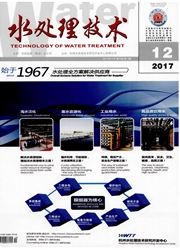

 中文摘要:
中文摘要:
以膨胀石墨、膨胀珍珠岩和竹炭为载体对T4、R4和D3三种石油菌进行吸附固定,研究柴油去除特性以及微生物在载体上的生长特性;用膨胀石墨一海藻酸钙法对三种石油菌进行包埋固定考察不同膨胀石墨掺杂量、交联掺氮方式对柴油去除效果的影响。研究结果表明,吸附固定微生物比悬浮生长微生物的柴油去除率更高,且以生物去除为主,其中膨胀石墨固定化石油菌和膨胀珍珠岩固定化石油菌的柴油去除率近100%。通过扫描电镜观察微生物在载体上的生长状态发现T4分泌有大量的胞外聚合物粘附在载体上,而R4和D3则没有。包埋固定得到的微生物菌剂对柴油的去除率均在80%以上,膨胀石墨掺杂量对T4影响明显,而采用交联掺氮的方式有利于D3对柴油的去除,0.1g膨胀石墨掺杂、交联掺氮处理后制得的D3菌剂对柴油的去除效果最好,达到了94.3%。
 英文摘要:
英文摘要:
Three oil degrading strains named T4, R4 and D3 were immobilized on expanded graphite, expanded perlite and bamboo-charcoal by sorption respectively. Diesel oil removal rate and bacteria growth characteristics on bio-carriers were studied. A kind of microbial inoculum was made by the method of EG-calcium alginate embedding and the effects of the volume of expanded graphite and the way of cross-linking with nitrogen on diesel oil removal rate were studied. The results showed that immobilized oil degrading strain by sorption had a higher diesel oil removal rate than suspended bacteria and mainly for biodegradation. Among the immobilized bacterium, diesel oil removal rates of bacterium immobilized by EG and bacterium immobilized by EP were nearly 100%. SEM was used to observe growth form ofimmobilized bacteria, it was found that thallus of T4 were united to form a thick layer of biofilm by bacteria's secretion on the cartier while D3 and R4 grew on the carrier neat and orderly. Diesel oil removal rates of embedding microorganism were all over 80%. The volume of EG had a significant effect on removal rate of T4 and the way of cross-linking with nitrogen was good for removal of diesel oil by D3. The microbial inoculum of D3 with 0.1g EG and nitrogen treatment during cross-linking had the highest diesel oil removal rate which was 94.3%.
 同期刊论文项目
同期刊论文项目
 同项目期刊论文
同项目期刊论文
 Adsorption of Pb(II) in aqueous solutions by bamboo charcoal modified with KMnO4 via microwave irrad
Adsorption of Pb(II) in aqueous solutions by bamboo charcoal modified with KMnO4 via microwave irrad P-benzoquinone-mediated amperometric biosensor developed with Psychrobacter sp. for toxicity testing
P-benzoquinone-mediated amperometric biosensor developed with Psychrobacter sp. for toxicity testing Adsorption-synergic biodegradation of diesel oil in synthetic seawater by acclimated strains immobil
Adsorption-synergic biodegradation of diesel oil in synthetic seawater by acclimated strains immobil Direct toxicity assessment of copper (II) ions to activated sludgeprocess using a p-benzoquinone-med
Direct toxicity assessment of copper (II) ions to activated sludgeprocess using a p-benzoquinone-med Bioframe synthesis of NF–TiO2/strawcharcoal composites for enhanced adsorption-visible lightphotocat
Bioframe synthesis of NF–TiO2/strawcharcoal composites for enhanced adsorption-visible lightphotocat 期刊信息
期刊信息
